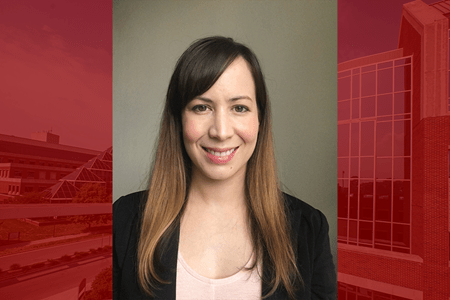In 2021, Indianapolis was deemed the 11th most violent city in the United States, based on Federal Bureau of Investigation crime reports. Ortiz, an assistant professor of surgery at Indiana University School of Medicine, is teaming up with gun crime analysis expert Lauren Magee, PhD, to stop the violence.
“Shootings have slightly decreased since the COVID period but remain at rates higher than pre-pandemic rates,” said Magee, an assistant professor at the Paul H. O’Neill School of Public and Environmental Affairs at IUPUI who studied health services research as a postdoctoral fellow in pediatrics at IU School of Medicine.
Her study published in BMJ Open in March 2022 determined that Indianapolis sees about 200 homicides and 700 nonfatal shootings per year—about two shootings every day. The 8.6% increase in non-fatal shootings during COVID surprisingly included more female and older adult victims, but the violence remained centered in the same disadvantaged neighborhoods.
 Suturing wounds, as Ortiz does every week, does nothing to curb this violence—unless it becomes the starting point for change in an individual’s life. That’s the vision behind Prescription for Hope (RXH), a hospital-based violence prevention program at Eskenazi Health founded in 2009 by the late Gerardo Gomez, MD, who led design of Indiana’s first Level 1 trauma center at Wishard Hospital (now Eskenazi) and founded the Surgical Critical Care Fellowship at IU School of Medicine.
Suturing wounds, as Ortiz does every week, does nothing to curb this violence—unless it becomes the starting point for change in an individual’s life. That’s the vision behind Prescription for Hope (RXH), a hospital-based violence prevention program at Eskenazi Health founded in 2009 by the late Gerardo Gomez, MD, who led design of Indiana’s first Level 1 trauma center at Wishard Hospital (now Eskenazi) and founded the Surgical Critical Care Fellowship at IU School of Medicine.
Now, as Prescription for Hope’s medical director, Ortiz continues Gomez’s vision for ending local violence.
“Victims of violence are at increased risk for reinjury and at risk for becoming perpetrators of violence themselves,” she said.
Ortiz has made several enhancements to the program using the agile science approach she learned from research mentor Malaz Boustani, MD, MPH, founding director of the Center for Health Innovation and Implementation Science at IU School of Medicine.
“It’s a big lift to gather the data, evaluate the data and have this continuous evaluation process, but that is my goal because I want us to be a learning health system,” Ortiz said. “We want to be able to fluidly utilize that data to change the things that aren’t working and modify the things that need to be improved—and do it in a quicker way than what we’re currently doing.”
Gun violence research ‘two decades behind’
Reversing the trajectory of violence in Indianapolis will take a collaborative care approach that’s both personalized and informed by solid data—something that’s been scarce.
Across the nation, there has been no standard reporting of firearm violence and few scientists working in the field due to a virtual moratorium on research imposed by the 1996 Dickey Amendment, which prohibited the federal government from using its funds “to advocate or promote gun control.” The law was reinterpreted allowing new grants from the Centers for Disease Control (CDC) and the National Institutes of Health (NIH) starting in 2020.
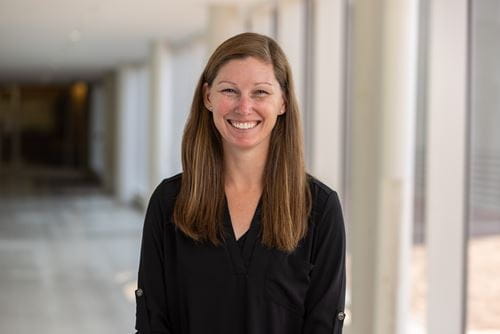 “We’re behind in reliable data and evidence-based practices by nearly two decades because we haven’t had many people doing this research,” said Magee, whose work in violence prevention started as a crime analyst with the Indianapolis Metropolitan Police Department. “Dr. Ortiz and I are trying to start a firearm injury collaborative across health systems to do this research here locally. We have to start with data to understand what’s working and what’s not.”
“We’re behind in reliable data and evidence-based practices by nearly two decades because we haven’t had many people doing this research,” said Magee, whose work in violence prevention started as a crime analyst with the Indianapolis Metropolitan Police Department. “Dr. Ortiz and I are trying to start a firearm injury collaborative across health systems to do this research here locally. We have to start with data to understand what’s working and what’s not.”
Although Prescription for Hope has helped more than 1,000 people since its inception, Ortiz needed to know if the program was really accomplishing its dual goals of reducing violent reinjury and new convictions for violent crime among those previously treated for penetrating wounds.
She led a recently published study comparing gunshot and stabbing patients who participated in Prescription for Hope from 2015 to 2018 to similar patients at IU Health Methodist Hospital who did not have access to the program.
The results were mixed.
“Prescription for Hope patients were about half as likely as controls to be violently reinjured, but they were still more likely to be convicted of a violent crime,” Ortiz said.
Her team theorized environmental factors may be at play in the results, including structural disadvantages of neighborhoods near Eskenazi Hospital and a patient population that skews younger, aligning with the statistical age of peak criminal activity in the early-to-mid 20s.
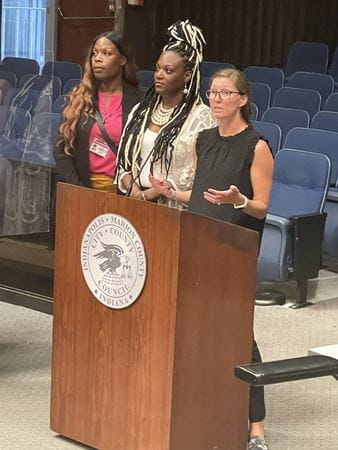 Still, the study revealed areas for improvement, particularly in tracking behavioral health outcomes. This led to routine screening of RXH participants for post-traumatic stress disorder (PTSD) and depression symptoms, and development of a program feedback survey.
Still, the study revealed areas for improvement, particularly in tracking behavioral health outcomes. This led to routine screening of RXH participants for post-traumatic stress disorder (PTSD) and depression symptoms, and development of a program feedback survey.
“We asked, ‘What’s important to you?’ and added patient-centered outcomes,” Ortiz said.
Through an Indiana CTSI Early Career Investigator award, Magee conducted in-depth interviews with survivors of shootings in the community to gain further insights and collaborated with Ortiz on the analysis. One thing they learned was many trauma patients needed help with tangible needs like safe housing, employment and transportation to health care appointments.
“It was important they feel independent, able to take care of themselves and their families, and able to self-regulate emotions while handling their sequalae of injuries,” Ortiz said.
Although shooting survivors and their family members suffer from increased rates of depression, anxiety and PTSD, few follow through with recommended mental health care.
“Many survivors prefer to deal with their trauma with family, friends and members of their own community—those who understand their lived experiences,” Magee said.
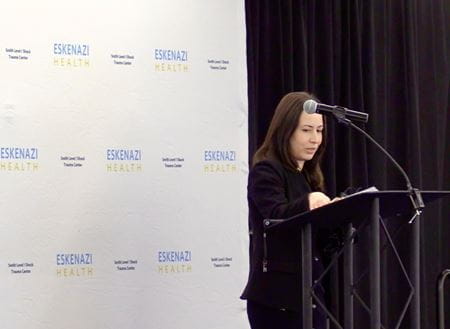 That’s why Prescription for Hope partners with local agencies and organizations who serve as “boots on the ground” within local communities. Among community partners, the Indiana Office of Public Health and Safety participates in a weekly information exchange including reports from “violence interrupters” deployed to the streets whenever there’s a shooting in the community.
That’s why Prescription for Hope partners with local agencies and organizations who serve as “boots on the ground” within local communities. Among community partners, the Indiana Office of Public Health and Safety participates in a weekly information exchange including reports from “violence interrupters” deployed to the streets whenever there’s a shooting in the community.
A new arm of Prescription for Hope, called Hope Reentry, employs violence intervention specialists who work one-on-one with young adult Black men on probation or parole using a holistic approach to keep them out of the criminal justice system.
“The most important thing is that they feel cared for, listened to, and not judged,” Ortiz said.
Personalizing violence prevention
Program goals include education on creating safer homes and neighborhoods and development of life skills for responsible citizenship. Participants may reach out to their care coordinator at any time for guidance and resources, and they are invited to attend a weekly support group for gunshot, stabbing and assault survivors.
“We engage those who are really ready to change their lives and get out of the environment that led them to their injury in the first place,” Ortiz said.
Progress is tracked at three- and six-months post-injury.
“It’s like a blood pressure cuff to see whether a person is improving, not improving or stable,” Ortiz said.
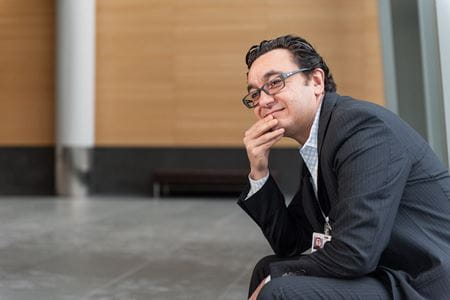
Combining data science with personalized care, Ortiz has implemented several key changes to the program. An institutional K12 grant is backing her current research to determine how well those changes are working.
Boustani expects positive, measurable results from his mentee’s efforts.
“Agile science provides insights to change the behavior of both one human and a cluster of humans who are organized in a social organization such as a city, a school or a hospital,” said Boustani, an expert on creating change conductors in health care. “It does leverage diversity and constraints to design effective, scalable and sustainable solutions for the violence epidemic in Indianapolis.”
Prescription for Hope recently conducted a series of community forums to gather and disseminate information among violence prevention partners in Indianapolis. One common myth, dispelled by Ashley Overley, MD, CEO of the Sandra Eskenazi Mental Health Center and assistant professor of clinical psychiatry at IU School of Medicine, is that increasing access to mental health services would decrease violent crime.
“That has been studied and is not true,” Ortiz said. “People with mental illnesses are more likely to be injured themselves, not commit violent crime. Behaviors that lead to violence are impulsiveness, lack of self-regulation and substance use.”
 Behavioral counseling is what’s most needed, but funding is limited. That’s why Ortiz is now advocating for RXH and similar violence prevention programs to be covered by Medicare and Medicaid.
Behavioral counseling is what’s most needed, but funding is limited. That’s why Ortiz is now advocating for RXH and similar violence prevention programs to be covered by Medicare and Medicaid.
In the meantime, she will keep analyzing the data to make continuous improvements to this innovative program in hopes of seeing violence in Indianapolis dramatically decrease.
“We will make sure we are using evidence-based practices and keep evaluating to see if these services are making the impact we think they are,” Magee added. “Ideally, we will see lower firearm violence rates than pre-pandemic and get to where we don’t have a topic to even research anymore.”
